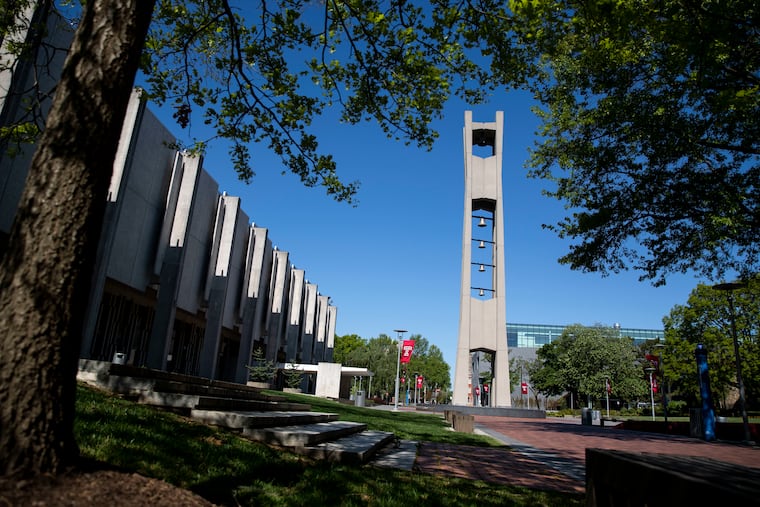Enrollment at colleges nationally continues to fall. ‘It is particularly troubling,’ researcher says.
“Although the decline has slowed and there are some bright spots, a path back to pre-pandemic enrollment levels is growing further out of reach," a chief researcher said.

A national report on fall enrollment at colleges shows another decline, though the rate has slowed from the prior two years, according to the National Student Clearinghouse Research Center.
The organization said the numbers are preliminary — so far 63% of the nation’s colleges that enroll 10.3 million students have reported — but the trend doesn’t bode well.
“After two straight years of historically large losses, it is particularly troubling that numbers are still falling, especially among freshmen,” Doug Shapiro, the center’s executive director, said. “Although the decline has slowed and there are some bright spots, a path back to pre-pandemic enrollment levels is growing further out of reach.”
» READ MORE: Freshman enrollment is up at some Philly-area colleges, though overall enrollment is nowhere near pre-pandemic levels
Overall enrollment, including undergraduate and graduate, fell 1.1%, compared with a 2.1% decline a year ago and a 3.4% decline in 2020 — the first fall with the pandemic, the center said. In Pennsylvania, the decline was steeper, 3%, and 5.9% from fall 2020, the report showed. Among just undergraduates, the losses were larger, 3.6% and 7.2%. Numbers for New Jersey were not available because not enough schools had reported.
The declines were on top of a previous drop from 2019 to 2020. The center said last spring that the undergraduate student body was 9.4%, or nearly 1.4 million students, smaller than pre-pandemic.
These trends are bearing out locally. An Inquirer survey of 32 local colleges earlier this month showed that 13 had seen an overall enrollment decline from last fall (although some had seen a larger freshman class), six cited an increase, seven said they were roughly the same, and six did not answer. The Inquirer generally focused on colleges with acceptance rates of more than 50%, leaving out highly selective schools such as the University of Pennsylvania, Princeton, and some others, which don’t face the same kind of challenges filling their classes.
» READ MORE: Here are fall 2022 enrollment numbers for Philly-area colleges and universities
Locally about a dozen colleges saw an increase in freshmen, some with significant jumps, which they were hopeful may mean the beginning of a rebound. But nationally, Shapiro said freshman enrollment was down 1.5%.
Shapiro said he was surprised by the enrollment losses this year, given that applications for federal student aid had increased. Either way, he warned the slower rate of decline doesn’t indicate recovery, nor does it mean schools have hit bottom.
» READ MORE: Overall enrollment decline in Pa.’s state universities rivals last year’s drop, but the number of freshmen is up
“We’re seeing smaller declines, but when you’re in a deep hole, the fact that you’re only digging a tiny bit farther is not really good news,” he said.
Colleges had been struggling with enrollment even before the pandemic, as the number of high school graduates fell ― with another decline due to begin in 2025 — and concerns increased about affordability, cost, and debt. Add to that a stronger labor market in recent years, wooing would-be students away from school.
But there were some bright spots, Shapiro said. Enrollment at historically Black colleges nationally was up 2.5%. Cheyney University, a historically Black state school that straddles the Delaware and Chester County border, did better than that, showing a 10% uptick, while Lincoln University, a state-related historically Black university in Chester County, decreased.
Another positive point nationally was community college enrollment, which saw a 0.4% decline, the smallest among sectors including public four-year, private nonprofits and private for-profits. Freshman enrollment seems to have stabilized at those schools for the first time since the pandemic. That was helped by an 11.5% jump in dual-enrolled high school students, the center said. Community colleges had been hit particularly hard by the pandemic, showing double-digit declines in enrollment in the previous two years.
And, additionally, the decline in overall enrollment of 1.1% is actually less than annual declines prior to the pandemic. In 2019, it was down 1.7%, Shapiro said.
But of concern, graduate enrollment saw a 1% decline, compared with an increase last year.
And while highly selective four-year colleges gained enrollment, all other four-year schools lost.
“The declines grew more steeply the further down [in selectivity] you went,” Shapiro said.